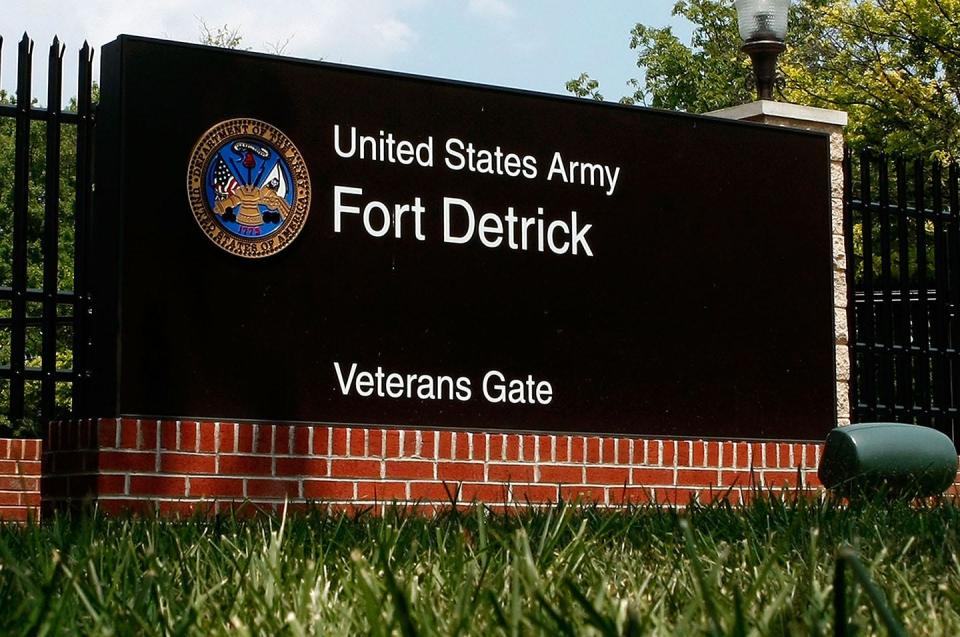State moves up 20 spots in economic momentum, but are Western MD, Eastern Shore seeing it?
- Oops!Something went wrong.Please try again later.
- Oops!Something went wrong.Please try again later.
Maryland Gov. Wes Moore said in a public conversation last week that the state has moved up 20 slots in economic momentum since he took office, but examining data more closely shows uneven growth statewide.
During a conversation Oct. 29 at St. John’s College in Annapolis with Washington Post Associate Editor Bob Woodward, well known for his reporting on Watergate, Moore said the state relies “on the eds, the feds, and the meds,” calling the education, federal government, medical sectors the “historic anchors” of Maryland’s economy.
Woodward, who picked up on an August statement of Moore’s where the first-year governor called the state’s economy “lazy,” asked Maryland’s chief executive: “How do you fix that?”

Moore responded by highlighting a “problem” with the state’s historic economic pillars.
“The problem is it has not fostered a sense of innovation, it has not fostered a sense of entrepreneurial growth,” he said. “It’s still far too difficult for businesses to be able to grow in the state.”
Maryland up 20 slots from a month before Moore took office
With Woodward, the Democratic governor referenced statistics from the Federal Funds Information for States, published in September, that showed Maryland ranked 27th in the country this year in economic momentum — a measure that includes personal income growth, employment growth and a state’s population growth.
Maryland ranked 47th last year, according to the same statistics, a fact Moore pointed out during his keynote address to the Maryland Association of Counties summer conference in August.
“The action was in the employment and personal income side of the equation,” said Dustin Chambers, professor of economics at Salisbury University, referencing the September data.
Employment growth grew 1.2% percent in Maryland between August 2022 and August 2023, a period in which the last seven or so months corresponded with Moore’s time in office after being inaugurated in mid-January.
During a similar time frame, personal income in Maryland grew 6.1%, a rate above the national average of 5.6%, helping the state move from the bottom to near the middle of national rankings.
Still, the state is below the national average, and lags neighboring states Pennsylvania (21), Virginia (19), and Delaware (18), as well as the District of Columbia (15). West Virginia (42) comes in over a dozen spots behind Maryland in the latest ranking.
More: President Biden lays out 'middle class' economic vision at Hagerstown Volvo factory
‘We’re not seeing as significant (of an) increase’
Paul Frey, president and CEO of the Washington County Chamber of Commerce, says that the state’s income growth has not been equal across Maryland.
“The rural areas, like Washington County and Western Maryland,” said Frey, “we’re not seeing as significant (of an) increase in prosperity.”
He noted an approximately $40,000 difference between Washington County’s median household income (about $67,000) and the state’s median household income, which in 2022 ranked No. 1 in the nation at about $108,000, according to the U.S. Census.

“The state’s doing well, and it makes sense why,” Frey said, “federal government workers,” referencing military installations at Fort Detrick in Frederick and Naval Air Station Patuxent River in St. Mary’s County as well as the National Institute of Standards and Technology headquartered in Gaithersburg.
More: Year In Review: Who were 2022's 10 biggest employers across Maryland?
On the Eastern Shore, in Wicomico County, where Salisbury University is located, median household income is also less than the state at $63,610.
The university’s Professor Chambers called diversifying the state’s economy a “challenge.”
“A lot of that’s about attracting start-up entrepreneurial talent to the state and getting them to start new businesses here,” he said.
Signs of growth
Both Chambers and Frey pointed to an entrepreneurship center on campus, or in Hagerstown’s case, a business incubator at the local community college, designed to spur economic development. Each individual highlighted their city’s most recent developments: in Salisbury, the updates at the airport; in Hagerstown, Conair, the appliance manufacturer, coming to town.
More: Port 44 and Ritchie Revival: Can targeted determination help rejuvenate communities?

Both highlighted as a positive the state’s low unemployment rate, 1.6% percent in September (lowest in the nation), and kept the door open for tech companies coming to town. Chambers said tech hubs like in Silicon Valley or Boston are not yet nearby.
“Maryland usually isn’t in that conversation, it could be,” he said. “I don’t know if there’s leadership on the governor’s part to try to stimulate that.”
Chambers asked rhetorically, is it “something that would have to happen organically or is there any public policy piece to guide it?”
Data centers and diversifying the economy
According to a November statement to the Frederick News-Post, the governor appears to be preparing to take the latter route of action with public policy.
After Aligned Data Centers, one of a few companies involved in starting the data center industry in Frederick, said it would stop work on a project in that county after a decision on energy generation was made by the state’s Public Service Commission, Moore vowed to press on with policies that could help bring the predicted 1,700 employees to work in a data center facility.
“Projects that diversify our economy and drive growth are what we need in Maryland. We must support and partner with emerging industries as they look to expand into our communities,” Moore said in a statement to The Frederick News-Post. “I will work with the legislature to address the (data) industry’s needs and ensure the industry has a bright future in Maryland.”
Frederick is less than an hour’s drive North up U.S. Route 15 from Loudoun County, Va., which has seen the highest concentration of data centers in the world. The sites south of the Potomac River store much of the world’s data in the “cloud” as well as the infrastructure associated with the shift to a digital economy.
The hi-tech warehouses, backed by Google, Amazon and Microsoft, have received both environmental scrutiny and community concern across the nation despite bringing billions in tax revenue to the communities that allow them.
Frey posited that the 180 acres of Mt. Aetna Park in Hagerstown could be developed that way, but cited the large amounts of water needed to cool such a site and the difficulties so far with energy that the project in Frederick has had as potential obstacles.
More: Struggling Maryland car dealers and tech companies hoping US semiconductor push will help
The Federal Funds Information for States is scheduled to release an end-of-year report in December or January. That report is also set to include updates to state’s population growth.
Maryland's population shrunk 0.2% from July 2021 to July 2022, a period which included much of the final year of Moore's predecessor, Republican Gov. Larry Hogan. Maryland ranked in the lower quarter of states in that category last year.
Dwight A. Weingarten is an investigative reporter, covering the Maryland State House and state issues. He can be reached at dweingarten@gannett.com or on Twitter at @DwightWeingart2.
This article originally appeared on Salisbury Daily Times: Are eastern, western parts of MD seeing state's economic momentum?

